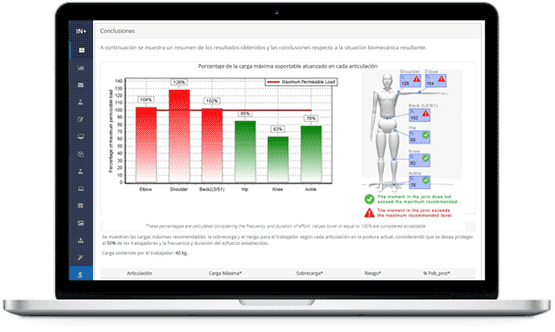

The Job Strain Index (JSI) is a job evaluation method designed to assess the risk of developing cumulative traumatic disorders in workers' upper limbs, specifically the distal areas, due to repetitive movements. This evaluation focuses on the hand, wrist, forearm, and elbow.
The JSI is calculated using six variables that produce six multiplier factors in an equation, ultimately yielding the Strain Index. A higher index signifies a greater risk of developing upper limb disorders. Evaluators measure the following variables: effort intensity, effort duration per work cycle, number of efforts per work minute, wrist deviation from the neutral position, task execution speed, and task duration per workday.
These variables and their corresponding scores are based on physiological, biomechanical, and epidemiological principles. Their purpose is to evaluate the physical strain on the muscles and tendons in the distal parts of the upper limbs resulting from task execution, as well as the associated psychological effort. Variables such as effort intensity and hand-wrist posture primarily assess physical strain, while the remaining variables gauge psychological load through task duration and rest time. The physical effort variables examine both effort intensity and the strain caused by performing tasks in postures that deviate from the hand-wrist system's neutral position.
The Job Strain Index method evaluates the risk of developing musculoskeletal disorders in tasks that heavily utilize the hand-wrist system, making it suitable for a wide variety of workstations. Moore and Garg from the Department of Preventive Medicine at the Medical College of Wisconsin, USA, originally proposed the method in 1995.
Subsequent studies have confirmed its validity, primarily for simple tasks (Rucker and Moore, 2002). Researchers have proposed extending its application to multi-task jobs using a calculation method similar to the Composite Lifting Index in the NIOSH lifting equation (Drinkaus et al., 2003).
Out of the six variables in the method, evaluators quantitatively assess four and subjectively measure the remaining two based on their perceptions, using scales like Borg's CR10 (Borg and Kaijser, 2006; Borg, 1998). Some consider this subjectivity a limitation (Borg, 2001), along with the fact that the procedure does not account for vibrations or impacts during task execution. Despite these limitations, the Job Strain Index remains one of the most widely used methods for analyzing upper limb risks.
Remember...
JSI is an evaluation method that assesses the risk of developing cumulative traumatic disorders in the distal part of the upper limbs due to repetitive movements.
Remember...
The Strain Index indicates the risk of developing disorders in the upper limbs, with a higher risk associated with a higher index.
Remember...
Some variables of the method are measured subjectively based on the evaluator's perceptions . This is sometimes considered a limitation of the method.
To apply the Job Strain Index method, start by identifying each task performed by the worker and the duration of their work cycles. Once you know which tasks to evaluate, observe each one and assign appropriate values to the six variables outlined by the method. Next, calculate the equation's multiplier factors for each task using the corresponding tables. With these factors, compute the Strain Index for each task as the product of the factors.
In summary, the application procedure for the method is as follows:
Determine the work cycles and observe the worker during several cycles.
Identify the tasks to evaluate and the required observation time (usually several work cycles).
Determine the value of the equation multipliers according to the values of each variable.
Calculate the JSI value and identify any risks.
Review the scores to determine where corrections need to be applied.
If changes are made, reassess the task using the JSI method to verify the effectiveness of the improvements.
The subsequent sections will detail the evaluation of different variables, the calculation of multipliers, and the determination of the Strain Index.
Qualitative estimation of the effort needed to perform the task once
Based on the effort perceived by the evaluator, a value will be assigned to the variable according to Table 1
| Effort Intensity | %MS2 | EB1 | Perceived effort | Score |
|---|---|---|---|---|
| Slight | <10% | <=2 | Barely perceptible, relaxed effort | 1 |
| A bit hard | 10% - <30% | 3 | Perceptible effort | 2 |
| Hard | 30% - <50% | 4-5 | Obvious effort; no change in facial expression | 3 |
| Very hard | 50% - <80% | 6-7 | Major effort; changes in facial expression | 4 |
| Near maximum | >=80% | >7 | Use of the shoulders or trunk to generate forces | 5 |
1 Comparison with the Borg CR-10 scale
2 Comparison with the percentage of Maximal Strength
Source: Moore, J.S. y Garg, A., 1995, The Strain Index: A proposed method to analyze jobs for risk of distal upper extremity disorders. American Industrial Hygiene Association Journal, 56, pp 443-458.
Measurement of the duration of the efforts.
To calculate effort duration, measure the duration of all efforts made by the worker during the observation period, which is typically several work cycles. Next, compute the percentage of effort duration relative to the total observation time. To achieve this, add the durations of all efforts and divide the resulting value by the total observation time. Finally, multiply the outcome by 100.
Ensure consistency in the units of measure for time throughout the process.
% duration of effort =
100 * duration of all efforts / observation time
Once the percentage of duration is calculated, the score corresponding to the variable will be obtained using Table 2.
| % Duration of effort | Score |
|---|---|
| <10% | 1 |
| 10% - <30% | 2 |
| 30% - <50% | 3 |
| 50% - <80% | 4 |
| 80%-100% | 5 |
Source: Moore, J.S. & Garg, A., 1995, The Strain Index: A proposed method to analyze jobs for risk of distal upper extremity disorders. American Industrial Hygiene Association Journal, 56, pp 443-458.
Frequency of efforts.
To calculate efforts per minute, count the number of efforts made by the worker during the observation time and divide this value by the duration of the observation period in minutes.
Efforts per Minute = Number of efforts / Observation time (minutes)
After determining the efforts per minute, use Table 3 to obtain the corresponding score.
| Efforts per minute | Score |
|---|---|
| <4 | 1 |
| 4-8 | 2 |
| 9-14 | 3 |
| 15-19 | 4 |
| >=20 | 5 |
Source: Moore, J.S. & Garg, A., 1995, The Strain Index: A proposed method to analyze jobs for risk of distal upper extremity disorders. American Industrial Hygiene Association Journal, 56, pp 443-458.
Estimation of hand anatomical position
Evaluate the deviation of the wrist from the neutral position, considering both flexion-extension and lateral deviation. Based on the wrist position observed by the evaluator, assign an score according to Table 4.
| Wrist Posture | Extension | Flexion | Lateral Deviation | Perceived Posture | Score |
|---|---|---|---|---|---|
| Very good | 0º-10º | 0º-5º | 0º-10º | Perfectly neutral | 1 |
| Good | 11º-25º | 6º-15º | 11º-15º | Close to neutral | 2 |
| Regular | 26º-40º | 16º-30º | 16º-20º | Non-neutral | 3 |
| Bad | 41º-55º | 31º-50º | 21º-25º | Major deviation | 4 |
| Very bad | >55º | >50º | >25º | Extreme deviation | 5 |
1Determine the wrist posture classification based on the ranges of extension, flexion, and lateral deviation. If several options are valid simultaneously, choose the least favorable one. For example, if there is a 27° extension (Regular) and a 23° cubital deviation (Poor), classify the hand-wrist posture as Poor.
Source: Moore, J.S. & Garg, A., 1995, The Strain Index: A proposed method to analyze jobs for risk of distal upper extremity disorders. American Industrial Hygiene Association Journal, 56, pp 443-458.
Qualitative estimation of the speed at which the worker performs the task.
Estimate the speed at which the worker performs the task qualitatively. Assign a score based on the work pace observed by the evaluator, using Table 5.
| Pace of work | Comparison with MTM-11 | Perceived Speed | Score |
|---|---|---|---|
| Very slow | <=80% | Extremely relaxed pace | 1 |
| Slow | 80% - <90% | Slow pace | 2 |
| Regular | 90% - <100% | Normal movement speed | 3 |
| Fast | 100% - <115% | Impetuous but sustainable pace | 4 |
| Very fast | >=115% | Impetuous and almost unsustainable pace | 5 |
1 Observed rate divided by the rate predicted by MTM-1 and expressed as a percentage.
Source: Moore, J.S. & Garg, A., 1995, The Strain Index: A proposed method to analyze jobs for risk of distal upper extremity disorders. American Industrial Hygiene Association Journal, 56, pp 443-458.
Time of the workday dedicated to the the task.
Determine the daily time in hours that the worker devotes to the specific task analyzed. Measure the duration of the task per day directly or obtain it from the personnel involved. Once you know the duration, use Table 6 to acquire the corresponding score.
| Task duration per day in hours | Score |
|---|---|
| <1 | 1 |
| 1-2 | 2 |
| 2-4 | 3 |
| 4-8 | 4 |
| >=8 | 5 |
Source: Moore, J.S. & Garg, A., 1995, The Strain Index: A proposed method to analyze jobs for risk of distal upper extremity disorders. American Industrial Hygiene Association Journal, 56, pp 443-458.
After assigning scores to the six variables, determine the multiplication factors by referring to the appropriate tables provided for each variable.
| Score | IE |
|---|---|
| 1 | 1 |
| 2 | 3 |
| 3 | 6 |
| 4 | 9 |
| 5 | 13 |
| Score | EM |
|---|---|
| 1 | 0.5 |
| 2 | 1 |
| 3 | 1.5 |
| 4 | 2 |
| 5 | 3 |
| Score | SW |
|---|---|
| 1 | 1 |
| 2 | 1 |
| 3 | 1 |
| 4 | 1.5 |
| 5 | 2 |
| Score | DE |
|---|---|
| 1 | 0,5 |
| 2 | 1 |
| 3 | 1.5 |
| 4 | 2 |
| 5 | 3 |
| Score | HWP |
|---|---|
| 1 | 1 |
| 2 | 1 |
| 3 | 1.5 |
| 4 | 2 |
| 5 | 3 |
| Score | DD |
|---|---|
| 1 | 0.25 |
| 2 | 0.5 |
| 3 | 0.75 |
| 4 | 1 |
| 5 | 1.5 |
The Job Strain Index is calculated using the equation:
JSI = IE x DE x EM x HWP x SW x DD
The equation is the product of the 6 factors calculated using the previous tables. Once calculated, we obtain the Job Strain Index, which is interpreted using the following criteria:
JSI values less than or equal to 3 indicate that the task is probably safe.
Scores greater than or equal to 7 indicate that the task is probably dangerous.
In general, scores greater than 5 are associated with musculoskeletal disorders of the upper extremities.
Borg, E. & Kaijser, L., 2006, A comparison between three rating scales for perceived exertion and two different work tests. Scandinavian Journal of Medicine and Science in Sports, 16, pp 57–69.
Borg, G.,1998, Borg’s perceived exertion and pain scales. Champaign, IL: Human Kinetics.
Borg, G., 2001, Rating scales for perceived physical effort and exertion. In W Karwowski (ed): International Encyclopaedia of Ergonomics and Human Factors. London: Taylor and Francis..
Diego-Mas, J.A., Poveda-Bautista, R. & Garzon-Leal, D.C., 2015. Influences on the use of observational methods by practitioners when identifying risk factors in physical work. Ergonomics, 58(10), pp. 1660-70.
Drinkaus, P ., Bloswick, D., Sesek, R., Mann, C., y Bernard, T., The Strain Index: Using Task Level Outputs to Evaluate Job Risk, 1st Annual Regional National Occupational Research Agenda (NORA). Young/New Investigators Symposium, Salt Lake City, June 12, 2003.
Moore, J.S. & Garg, A.,1995, The Strain Index: A proposed method to analyze jobs for risk of distal upper extremity disorders. American Industrial Hygiene Association Journal, 56, pp 443-458.
Rucker, N. & Moore, JS.,2002, Predictive validity of the strain index in manufacturing facilities. Applied occupational and environmental hygiene, 17, pp 63-73.
Diego-Mas, Jose Antonio. Evaluation of the repetitiveness of movements using the JSI method. Ergonautas, Universidad Politécnica de Valencia, 2023. Available online: https://www.ergonautas.upv.es/ergoniza/app_en/land/index.html?method=jsi
A cloud based software that integrates more than 20 tools for managing the ergonomics of the workstations in your company.
Evaluate all ergonomic risk factors of the workstations in your company: inadequate postures, repetitive movements, load handling, thermal environment...

Use Artificial Intelligence for the automated detection of postures in photographs or videos.
Generate fully customizable reports in Microsoft Word or Adobe Pdf format.
In a multiuser environment so that your company can have access to your data everywhere.
You only need a free account on Ergoniza
ERGONIZA allows you to use Artificial Intelligence for postural load assessment. Automatically capture workers’ postures from a photograph or a video and obtain an automated evaluation of the risk associated with inadequate or forced postures.
AI in actionERGONIZA helps you manage the ergonomics of the workstations of your companies. Evaluate all the risk factors present in the workstations, manage the evaluations, and obtain editable and customizable reports.
You only need to register as a user of ERGONIZA to start testing.
Sign UpUnlock the full potential of Ergoniza. By becoming a Pro User you'll have access to all of Ergoniza and be able to use all of the online software without restrictions or time limits. You'll be able to use the results of evaluation methods and tools in your professional activity. You'll be able to print the results reports in pdf or Word and save your studies in files to open them later.
To register as a Pro user, you must first login to Ergoniza.
(*) In European Union countries, the price will be increased with the corresponding VAT.
(**) The price in american dollars has been calculated at the current exchange rate and may vary.
is a web by . Ergonautas is the specialized website in occupational ergonomics and ergonomic assessment of workstations at the . Ergonautas aims to be a useful support tool for the Occupational Risk Prevention and Ergonomics professional and people in training, providing rigorous technical information on occupational ergonomics, online tools for its application, research, training, and participation forums.
Ergonautas is formed by a large human team. In addition to technicians and programmers, the Ergonautas team is made up of researchers and professors from the Polytechnic University of Valencia. The team, led by José Antonio Diego Más, is at the forefront of research and teaching in ergonomics, teaching in official degrees and master's degrees, and developing research projects in the field of ergonomics and new technologies oriented towards humans.
If you need to know more, get in touch with Ergonautas
Or follow us on Linkedin
- - -
© 2006 - Universidad Politécnica de Valencia




